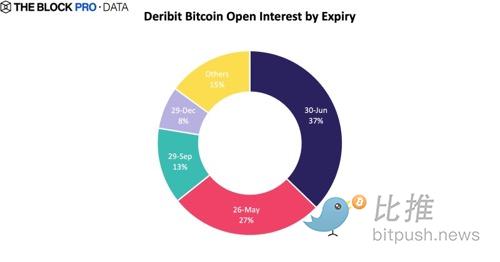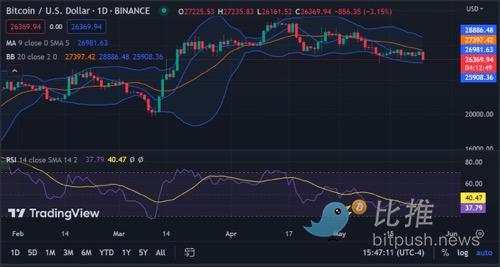Multiple macroeconomic negative factors have hit the market, causing Bitcoin to drop below 26,000 US dollars in the short term.
Several negative macroeconomic factors caused Bitcoin to fall below $26,000 recently.Author: BlockingBitpushNews Mary Liu
After nearly half a month of sluggish consolidation, the cryptocurrency market has further retreated under the influence of UK inflation data, the latest Federal Open Market Committee (FOMC) meeting minutes, and the latest warning from US Treasury Secretary Yellen about the US debt ceiling impasse. According to data from the Blocking terminal, as of press time, the trading price of Bitcoin has fallen below $26,400, down about 3% in the past 24 hours, approaching the lowest level since May 12.
Macro uncertainties on multiple fronts
Earlier on Wednesday, the cryptocurrency market plummeted after the latest Consumer Price Index (CPI) for April in the UK rose to 6.8%, higher than the expected 6.2%, reaching the highest point since 1992. The disappointing CPI means that the Bank of England will have to continue its recent rate hike policy, which usually hits the cryptocurrency market.
The latest FOMC meeting minutes showed that Federal Reserve officials are divided on the issue of further interest rate hikes, which also does nothing to boost market confidence.
- Macro negative factors continue to ferment, and Bitcoin may weaken in the short term and test $26,000.
- New Order: Money Meme – When Game Theory Meets Memes
- Web3 Marketing Handbook: How to Disruptive Products to Mainstream Market
On Wednesday, US House Speaker Kevin McCarthy said that the debt ceiling negotiations are still unresolved, and there are eight days left before the US faces default risk. He also said he believed the negotiating team could make progress on Wednesday.
Since early May, the market has been weighing the US government’s debt ceiling negotiations and ongoing cryptocurrency regulation and macroeconomic uncertainties, and BTC has been struggling in low trading volumes and volatility, with trading prices remaining in the range of $26,500 to $27,500.
Ruslan Lienkha, Market Director of the fintech platform YouHodler, wrote in his blog post that “the escalating financial market tension” has had an impact on stocks and digital assets.
Lienkha wrote: “As concerns about a possible US default intensified, US stock indices faced selling pressure: with less than 10 days left for the authorities to reach some kind of agreement, we have not seen any progress in these negotiations. All this uncertainty is forcing financial institutions to restructure their assets and prepare for a possible default, which is putting additional pressure on market participants.”
The cryptocurrency market is following the US stock market, according to David Wells, CEO of Enclave Markets, who told CNBC: “Although cryptocurrency is a global market, trading volume tends to pick up significantly during US trading hours, so sometimes big crypto movements happen after macro-driven stock market movements.”
Some analysts believe that even if the US government is able to raise the debt ceiling before the June 1 deadline, risk assets such as stocks and cryptocurrencies may still be impacted because the issuance of new US Treasuries will drain liquidity from the market.
For example, according to Reuters, US money market fund assets hit a new record of $5.8 trillion this week as investors turned their attention to short-term debt securities. Fixed-income mutual funds are the main source of funding for corporations and municipalities, and have faced net inflows of $615 billion so far this year.
Deribit: Implied trading volume still at its lowest level
Luuk Strijers, Chief Business Officer of crypto futures and options exchange Deribit, tweeted that $3.6 billion worth of Bitcoin and Ethereum options contracts will expire on Deribit this Friday, but the impact may be minimal due to the market being at one of its lowest volatility levels of the year.
Strijers said that the put/call ratio is 0.38 and unfinished call options may be more than two and a half times the number of put options. The expiring option amount is considerable, but that doesn’t mean there is reason for the market to panic.

He said: “The implied trading volume is still at its lowest level, with Deribit Bitcoin Volatility Index (DVOL) at 50 for both Bitcoin and Ethereum, and short-term trading volumes even lower but slightly increasing at the same levels as Bitcoin and Ethereum, which is rare in history. We saw a similar situation of lowest implicit volatility (IV) in January this year, followed by a sharp rise.”
BTC 24-hour price chart suggests downward trend
The 24-hour price chart tracked by crypto analyst Ann Mugoiri shows that the bearish momentum is increasing, and the Bitcoin price has been steadily declining. The bears have successfully controlled the market, pushing BTC/USD down to a low of $26,106.

Additionally, BTC’s relative strength index (RSI) is at 37.79 and recently breaking below its signal line indicating that BTC is currently in a bearish market, which is a potential buying opportunity for investors looking to take advantage of the current market conditions. The Bollinger Bands are also narrowing, indicating that volatility is decreasing and consolidating within a certain range. The upper band of the Bollinger Bands is at the $28,886 level and the lower band is at the $25,908 level. The moving average (MA) indicator also shows a bearish sentiment as the 50-day moving average crossed below the 100-day moving average.
The 24-hour Bitcoin price analysis chart shows that Bitcoin is in a strong downtrend with bear dominance. BTC/USD has formed a series of lower highs and lower lows, indicating that selling pressure is intensifying. Ann Mugoiri believes that if it continues to fall, it may test the $26,000 level, and the market continues to be dominated by bears, with any signs of recovery still a long way off.
We will continue to update Blocking; if you have any questions or suggestions, please contact us!
Was this article helpful?
93 out of 132 found this helpful
Related articles
- DeFi Narrative Losing Popularity: How Can Outdated Blue Chips Regain Market Attention?
- Story behind the sudden rise of PulseChain, which excavated 500 million TVL in a week
- Hong Kong to open cryptocurrency trading to retail investors, bitcoin rebound may be weak or unsustainable
- Introducing BTC Warp: A Proof of Concept solution for Bitcoin Light Node Synchronization Issue
- Risks and Opportunities in the Bitcoin Ecosystem (Part 1)
- Binance Research’s lengthy article: Bitcoin BRC-20 principles, current status, and future
- What is your opinion on the Democratic presidential candidates accepting Bitcoin as campaign donations?




